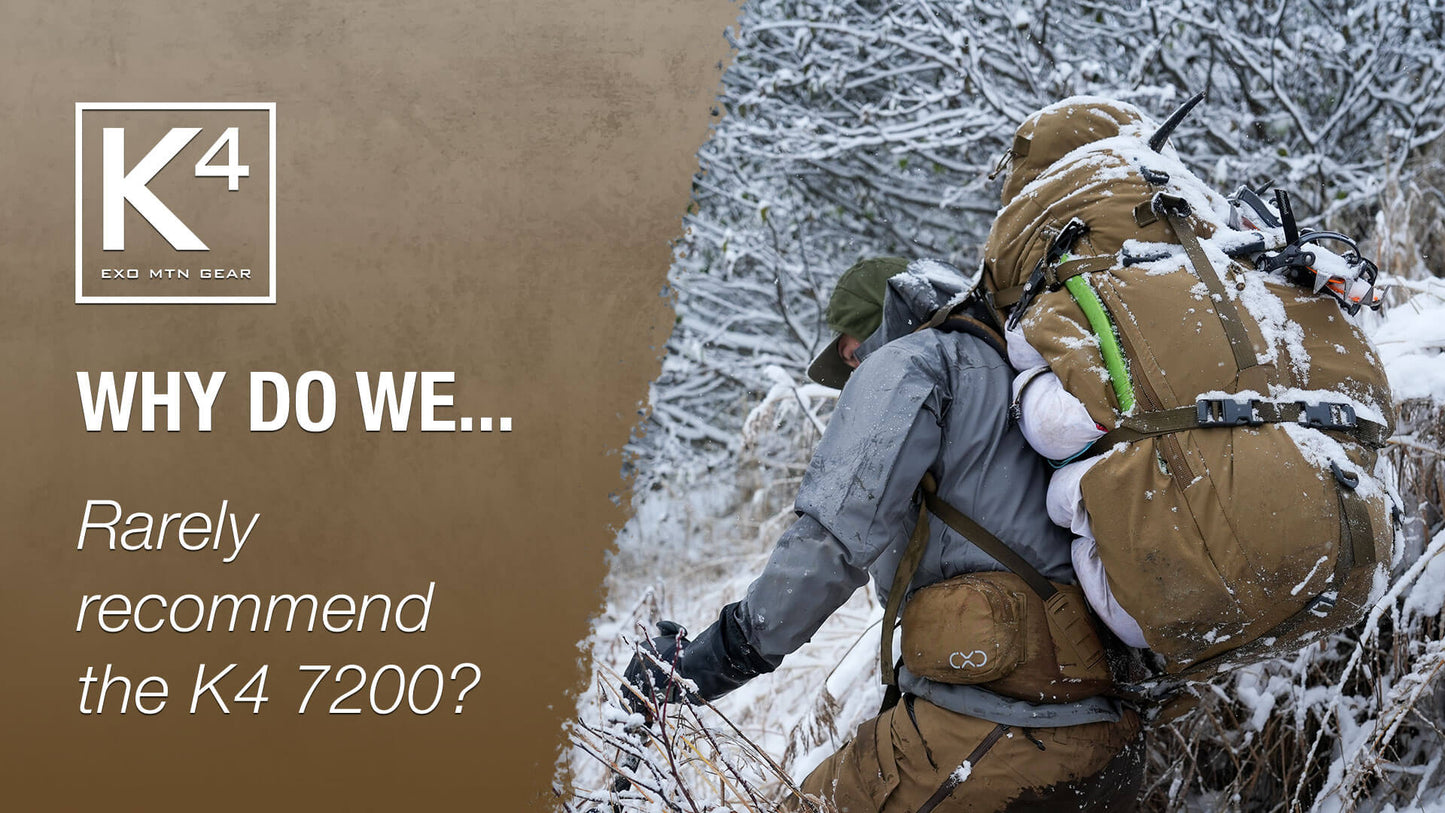
Welcome to the "WHY DO WE?" video series.
Every stitch and square inch of our K4 Packs are designed on purpose and built for a purpose. The videos in this series will go behind the design to explain why we build our packs the way we do.
This video explains why we make the K4 7200, but rarely recommend it. As we discussed in previous Why Do We? articles, performance is the priority in everything we do. And any recommendation we make to our customers will always be to provide the best fit, comfort, and performance from our packs.
So while the K4 7200 is only a few ounces heavier (and costs just $25 more) than the K4 5000, there are good reasons to avoid the K4 7200 bag, unless you truly NEED it…
PERFORMANCE > PREFERENCE
Once again, let us reiterate that we talk people out of the 7200 (at times), not because a different bag is our preference, but because we want all of our customers to experience the best performance. There are times when the 7200 is the best choice, and we will explain those later in this article.
But in working with thousands of customers, we have noticed that it is common to a fair number of people to think "bigger is better" without realizing that there are consequences to getting a bigger bag "just in case" or because "it is only slightly heavier" or that, "I want to have extra space and not need it, rather than need more space and not have it."
As Steve discusses above, HOW you load your pack is extremely important. You want to use the full length of the frame and keep all of the load as close to your back as possible. If you want to learn more about pack-loading principles and see examples of how we load our packs, you can see How To Load Your Pack For A Multi-Day Backpack Hunt or How To Load (And Compress) Your Pack For A Day Hunt.

The K4 7200 compressed (left) vs expanded (right)
While the K4 7200 does compress well (as all of our bags do), if you never truly need the full capacity the 7200 offers and are constantly making the bag smaller, you would be better off with a smaller bag to begin with.
DO YOU (REALLY) HAVE A 7-10 DAY HUNT?
On the surface, the duration of your hunt greatly influences the capacity of the pack you need. But if we ask more questions, we will get the best answer. And the best pack.
Those questions may include... Where and when is the hunt? What is the style of the hunt? Are you hiking in, flying in, floating in, or riding in? Once you are in the hunt area, are you setting up a base camp?
Those questions are examples that help clarify what we need to distill all of this down to. And that is...
Just because you have 10 days to hunt, that doesn't mean you'll be carrying all of your gear and food for 10 days at once.
You could be going on a 10-day caribou or moose hunt in Alaska, but you'll be flown in, dropped off, and hunt out of a basecamp for those days. It is a "10-day hunt", but from a pack standpoint, all you need is a bag that is big enough to carry the essentials while you hunt away from camp for the day. Even if you may "spike out" for a night or two (or 5!), the K4 7200 would still be much bigger than you need.
Even if you are doing a self-supported, backpack-style hunt for over a week, you may still be able to use the K4 5000. Mark used a K4 5000 on his week+ backpack Dall Sheep hunt in Alaska; you can see his full gear breakdown here.
Mark with his Dall Sheep, loaded in his K4 5000
Alaska aside, some customers ask about the 7200 for an extended elk or mule deer hunt in the Rockies. Often, these extended hunts are either broken up into shorter durations — try a spot for 2-5 days, then move to another spot. Or it is more of a "backcountry basecamp" style of hunt where you may pack a week+ worth of gear into the backcountry at once. But once you set up base camp, you are hunting for shorter durations from that basecamp — not hunting with all week+ of food and gear on your back.
An often-overlooked option for a "backcountry basecamp" hunt like that would be to use a K4 5000, and if needed, utilize the load-shelf area for that initial pack-in. Then, once you have camp set up, you'll have plenty of space as you hunt away from your basecamp for the duration of your trip.
IF YOU HAVE SPACE, YOU WILL FILL IT
Or as Andrew Skurka said, "We pack our fears."
Many of the customers who ask about the 7200 are newer to backpacking and/or backpack hunting. And since they lack the experience to know what they need, they err on the side of having more space for the unknown.
If you pair a big'ol bag with that person's lack of experience, they will fill the bag to the brim with just-in-case items. The result is a newer backpack hunter with an overly-heavy backpack, who is both literally and figuratively "weighed down" by the difficulty and complexity of backpack hunting.
If you are a new backpack hunter, we are here to help you, not judge you. Take one of our gear lists as an example, adapt the specific items to what you have or can afford to buy, and do your best not to add many items not listed on the list or to "pack your fears". And if you are buying one of our backpacks for any hunt up to a week in length, get a K4 5000 Pack System.
WHEN THE K4 7200 MAKES SENSE
Now that we have told you why you may not need a K4 7200, let's talk about some situations where the 7200 does make sense.
One of the primary reasons we make the K4 7200 is for hunting guides. Professional guides not only spend a lot of time in the field on long-duration hunts, but they often end up carrying extra gear or supplies for their clients. We know plenty of guides who do high-adventure hunts and need a bag like the K4 7200 to do their job well. (Side note: if you are a professional guide, we do have a Guide & Outfitter purchase program.)
Guide or not, if you have extended backpack-style hunts in demanding conditions, the K4 7200 may be warranted. A good example of this would be the mountain goat hunt in Southeast Alaska that Mark & Jake from Exo Mtn Gear completed last October. (Watch the Hunt: Part 1 | Part 2)

Mark climbs into mountain goat terrain with his loaded K4 7200
In addition to the duration of that hunt being planned for more than a week of backpacking, there were extra considerations required for cold-weather gear with temps dropping well below freezing, crampons for safety on steep, snow and ice-covered terrain, some bulkier synthetic insulation pieces for the wet environment of coastal Southeast Alaska, and some extra gear for the boat-based travel portion of the hunt. The K4 7200 was a good choice for this extended backpack hunt in demanding conditions, and the requirement of specialized gear for unique circumstances.
Beyond guides and/or extended backpack hunts in demanding conditions, the next reason(s) to consider the K4 7200 were perfectly illustrated in a phone call that I received just a few minutes ago, as I was writing this article...
I answered a call from a customer (let's call him Frank) who asked about buying the K4 5000 or the K4 7200. And believe it or not (given everything this article has said up to this point), I recommended the K4 7200 for him.
The first factor is that Frank told me he was 6' 6" tall and weighed 280lbs. His physical stature isn't the sole reason to recommend the K4 7200, but it is worth considering that bigger guys with bigger gear may need more space in their pack. Frank's clothing, shelter, and sleep system will require more space than the gear of someone who is 5' 9" and 170.
Secondly, Frank also said he would be backpacking with young kids. As a Dad, he will end up carrying some, if not most of, his kids' load. A guy his size, with bigger gear, and the extra burden of helping carry gear for others — that combination of factors is a good reason to recommend the K4 7200.
IF YOU USE IT, USE IT WELL
At Exo, we always come back to two things: making the best product possible and taking care of our customers as best as we possibly can.
We do everything we can in those two areas, but you (if you use your packs) also have some responsibility to achieve the best performance from your pack.

Jake with a day's worth of gear in his compressed K4 7200 (while on the mountain goat hunt mentioned above)
We already mentioned this above, but it is worth repeating as we conclude — please take some time to load your pack properly, and when it is not full, to compress it well. That is true with all of our bags, but it is especially true with the K4 7200.

